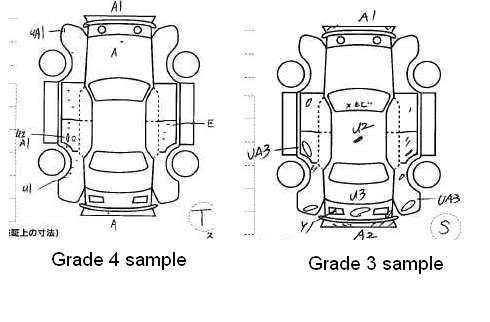🇯🇵👨⚖ Japan Car Auction Grading
The purpose of the Auction Grade is to give anyone a quick idea of the general condition of a vehicle. The grade is the overall assessment of a vehicle given to it by a Japanese car auction house’s own assessors.
There is a range of different quality levels within each grade. So a car that is classified as a grade 4 may be almost a grade 4.5 in quality terms, or it may be only just above a grade 3.5.
There are usually two grades:
- The overall grade based on the exterior and mechanical condition (usually a number), and
- The interior grade, based on the interior condition (usually a letter - A, B or C).
Although different auctions may have slightly different methods of determining each grade, in general they are similar.
Overall Grade
| Grade | Vehicle Quality Condition |
|---|---|
| 7, 8, 9 or S | A new car that is being sold in an auction, with only delivery mileage. |
| 6 | Similar to the news cars above but with a little more than delivery mileage. |
| 5 | Exceptionally low mileage and in mint condition. |
| 4.5 | Excellent condition, but can also have mileage of up to 100000KMs. |
| 4 | A good, solid car. Mileage is not an issue and can be low or high. |
| 3.5 | Similar to a Grade 4 but may need more paint and panel work. Alternatively, it may have high mileage. |
| 3 | Often has either serious paint and panel, or it has had a panel replacement somewhere. Grade 3 cars can also be basically grade 3.5s in terms of condition, but with very high mileage. |
| 2 | Reserved for vehicles in the worst condition. This does not mean that they are write offs, simply that they have experienced deterioration such that they are now in a very poor state. A grade 2 vehicle will often have corrosion, perhaps corrosion holes and other serious issues. If you are looking for "classic" and other older cars or older trucks and buses, you will find a number of them are grade 2. |
| 1 | Can be one of the following: 1) Aftermarket turbo/engine (some sort of serious modification to the original vehicle); 2) Transmission changed from auto to manual. |
| A, R, RA | Are repair history cars. The auctions definition of "repair history" is a car that has had an inside panel repaired in some way. This can range from extremely minor to major. |
| ??? | Ungraded write off cars which may not move at all. Auctions provide no information about these cars on the auction sheets. If the cars are drivable, then there should be no additional transportation costs. However, if the motor does not start or if the car cannot move under its own power for some other reason there may be problems in getting it from the auction to the port, and then from the yard onto the ship. If the engine does not start and is not steerable, transportation and port costs can skyrocket. |
| *** | Vehicles with major engine trouble or significant accident damage, and it is unlikely to move under its own power. These vehicles have not been repaired and may have serious mechanical or body faults. They are sold as-is by the auction with little to no information about their condition, making them a risky purchase that could result in additional costs if they cannot be driven or moved. |
Exterior and Interior Grading
Some auctions have a letter, A, B or C to denote the exterior and interior grade separately. These letters can be seen near the overall grading number. A is excellent, B average and C below average.
Car Map
On the map, the letter denotes a type of damage and the number after the letter denotes the severity of the damage.

| 1 | light | A | Scratch |
| 2 | moderate | B | Dent with scratch |
| 3 | significant | C | Corrosion (rust has progressed so that now the original metal is now flaking away) |
| 4 | major | E | Dimple |
| G | Stone chip on glass | ||
| H | Paint faded | ||
| P | Paint marked | ||
| S | Rust (orange discolouration on the surface) | ||
| U | Dent | ||
| W | Wave, or repaired area | ||
| X | Item that needs replacing | ||
| XX | Replaced panel / item | ||
| Y | Crack |